We provide daily automatic WordPress backups, as well as system-generated backups for all sites on your account. These backups, along with your manual backups, are available as restore points in MyKinsta. Follow the steps below on how to create a WordPress backup and how to restore one if needed.
WordPress Backups
Each backup is a complete snapshot of a site environment’s files, database, redirects, and Nginx configuration at the time the backup was created. Note that the timestamps for backups you see in MyKinsta are based on your local system time, not the timezone of the region your site is hosted in.
When you restore a backup, all changes to the website’s files, database, redirects, and Nginx configuration will be rolled back to the time the backup was created.
WordPress backups can be found on the backup tab of each of your sites (WordPress Sites > sitename > Backups) and are divided into five different sections:
- Daily: We create a backup automatically every day.
- Hourly: We offer an hourly backup add-on for users who need more frequent backups.
- Manual: You can create up to 5 manual backups, which are stored for a minimum of 14 days (but can vary depending on your plan). These are recommended when you’re rolling out a change on your live site, which perhaps couldn’t be tested on staging.
- System generated: We create an automatic system backup at certain events (for example, when you restore a backup, a system backup is automatically generated).
- External: With our external backup add-on, you can make weekly or monthly backups to Amazon S3 or Google Cloud Storage.
- Download: You can create a downloadable backup once per week. Unlike the snapshot-based backups above, the downloadable backup will create a downloadable ZIP file containing only your WordPress database and files.
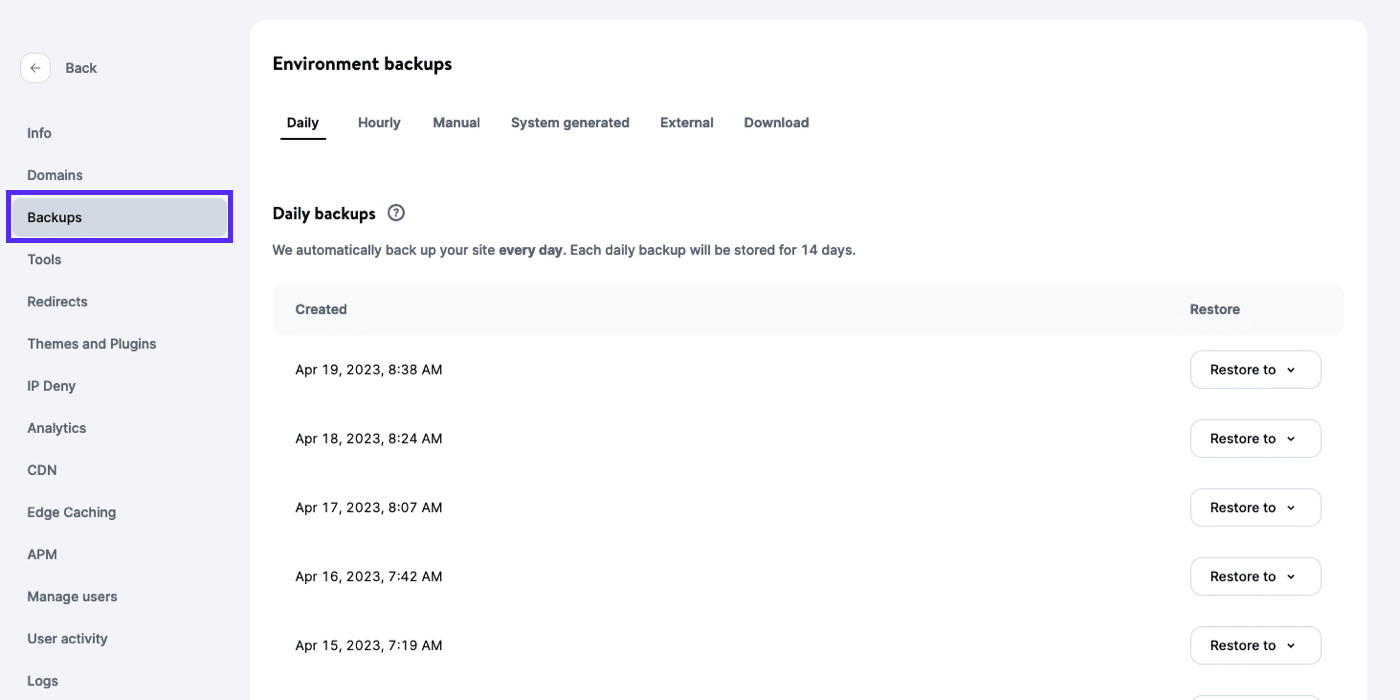
Create a Manual WordPress Backup
Step 1
In MyKinsta, go to your site and click on the Backups tab. Next, click on the Manual tab and click the Back up now button to create an additional backup manually.
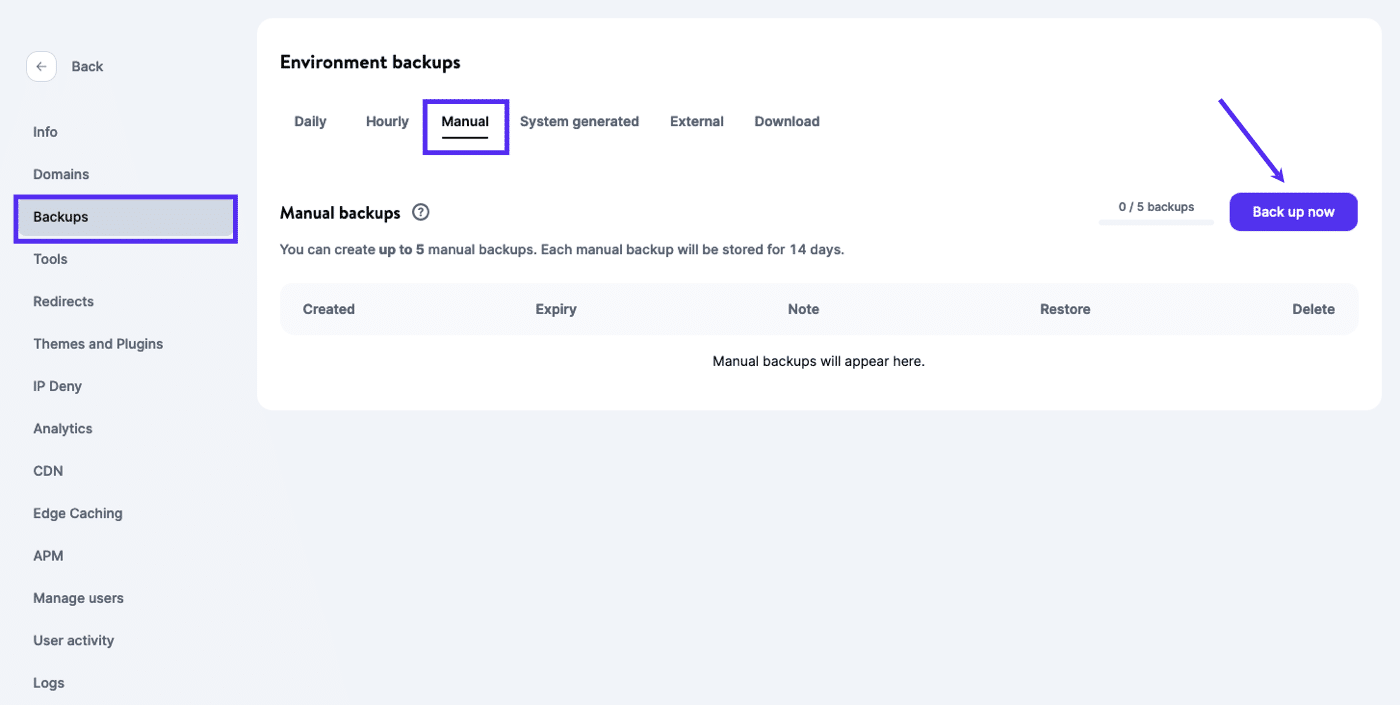
Step 2
You can add a short identifier note to your backup. Then click on Create backup.

If you need to make more than 5 manual backups in 14 days, you’ll need to delete one of the manual backups to make room for a new one.
Downloadable Backups
You can download an archive file (.zip) containing your entire WordPress site. The archive file contains your website’s files and the SQL file with the contents of your database.
- You can create a downloadable backup once per week.
- The downloadable backup will be available for you to download for 24 hours.
A backup won’t contain any MyKinsta settings or custom server-side configurations, such as:
- Redirects
- Custom Nginx rules
- Blocked addresses in IP deny
- Changes in PHP or MySQL configuration
- Add-ons
Downloadable backups are available at WordPress Sites > sitename > Backups > Download in MyKinsta.

Step 1
Click the Create backup now button. Creating the backup may take several minutes, depending on the size of your site. Once it’s ready, you will get a message in MyKinsta and an email with a download link.

Step 2
When your backup is ready, click on the “Download the backup now!” link in the email or the Download button in MyKinsta. Save this to your local computer, where you can unpack it and view the files.

The backup is a .zip file that contains all of your website’s files (inside the public directory) and a database file (sitename.sql).
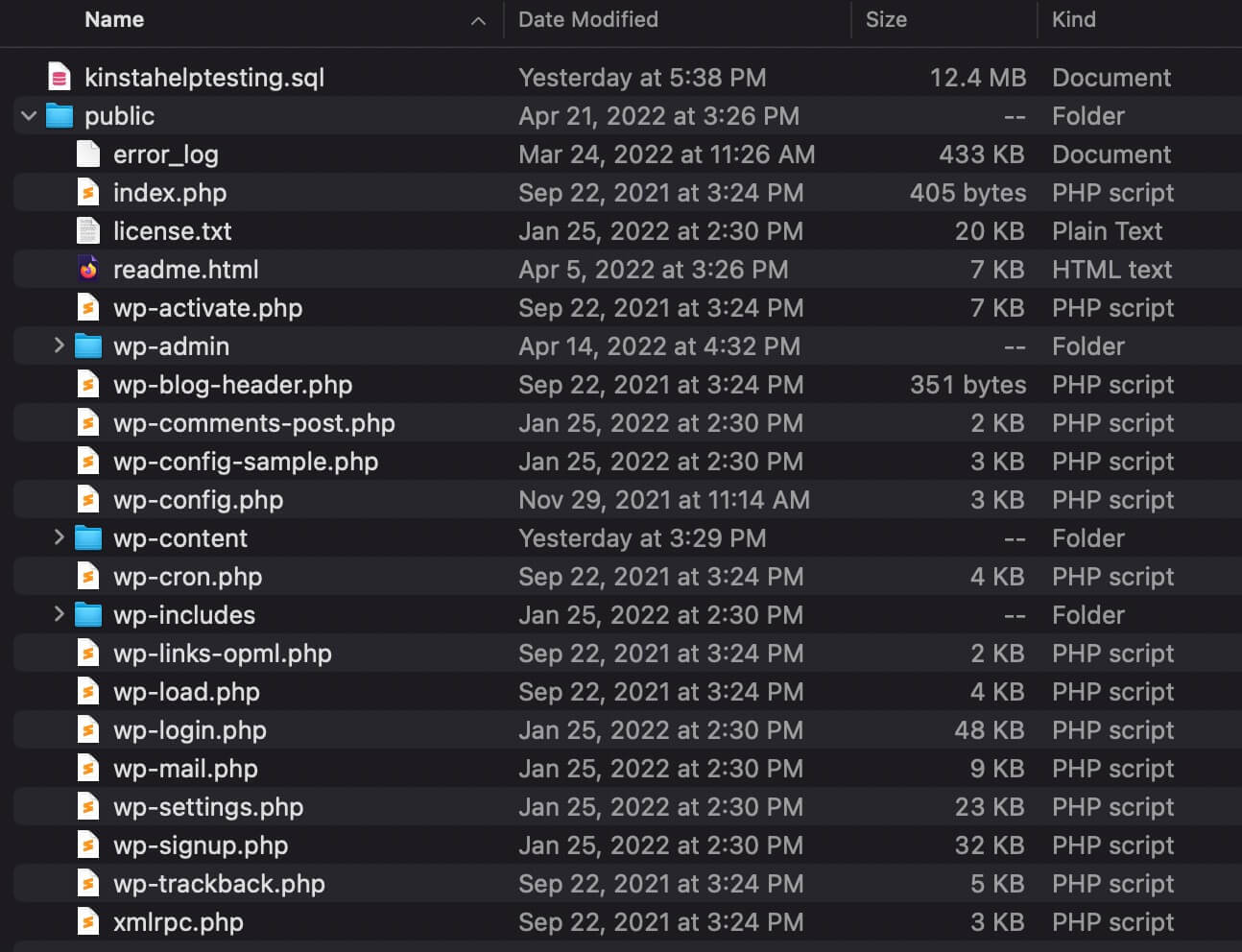
Hourly Backups Add-on
We have an hourly backups add-on available if need additional restore points. You can find this under WordPress Sites > sitename > Backups > Hourly.
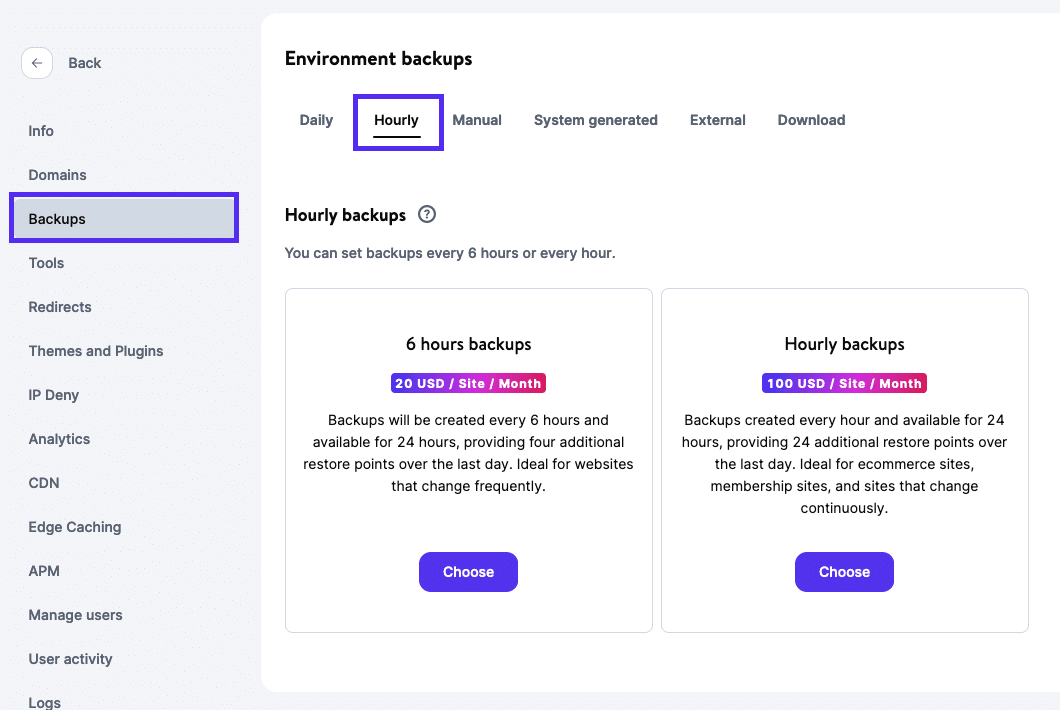
Within hourly backups, you have two options:
6-Hour Backups
- $20/site per month
- Backups will be created every 6 hours and are available for 24 hours. Ideal for websites that change frequently.
Hourly Backups
- $100/site per month
- Backups will be created every hour and are available for 24 hours — ideal for ecommerce sites, membership sites, and sites that change continuously.
To enable one, click the Choose button, review the details, and click the Enable backups button. You will not be billed immediately. You will be billed for the add-on at the beginning of your next billing cycle. That bill will include the add-on’s cost for the remainder of your billing cycle and the cost of the following billing cycle.
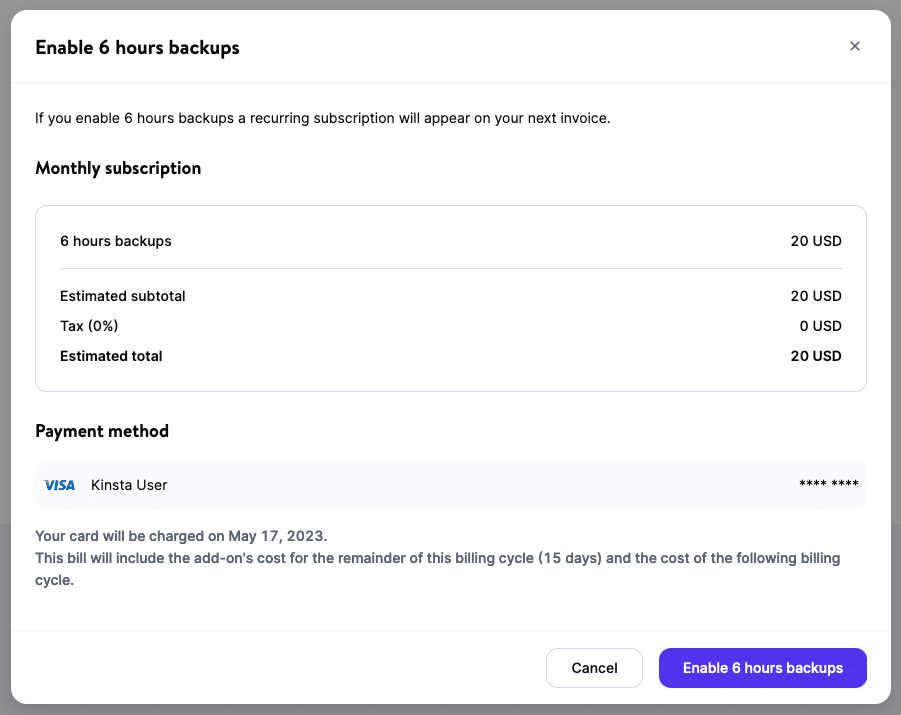
You can view and restore your hourly backups at any time from Backups > Hourly, as well as make changes to the add-on (upgrade or downgrade the frequency or cancel the add-on). Again, these are additional restore points. Automatic daily backups are still taken and available to restore when 6-Hour or Hourly backups are enabled.

External Backups Add-on
You can automatically back up your WordPress site to Amazon S3 or Google Cloud Storage with our external backups add-on. External backups can be configured for either weekly or monthly frequency, and you also have a choice between backing up your files, WordPress database, or both.
Our external backups add-on lets you build off-site backups into your disaster recovery strategy without configuring complex WordPress plugins to connect to an external storage provider.
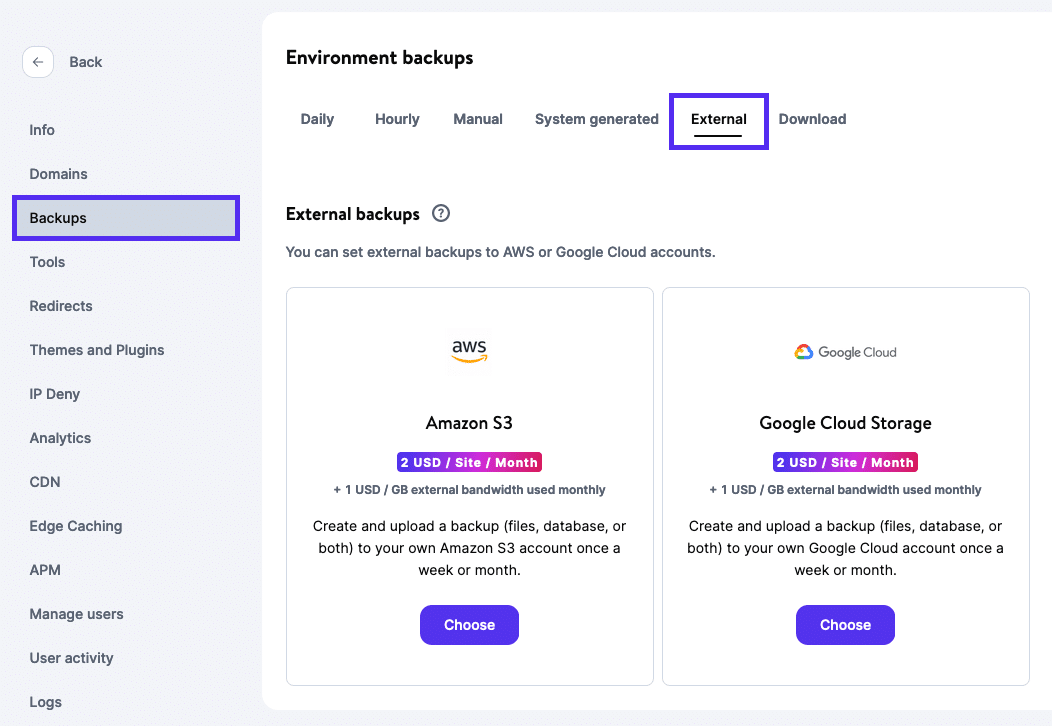
The external backup add-on is available to all Kinsta customers for $2 per month for each site plus $1/GB for external bandwidth.
To enable external backups for your WordPress site, go to WordPress Sites > sitename > Backups > External. From here, you can select either Amazon S3 or Google Cloud Storage for your external storage integration.
Restoring WordPress Backups
You can restore automatic, manual, and system-generated backups in MyKinsta. To restore your WordPress site from a backup, click the Restore to button next to the backup you want to restore, and select the environment you want to restore the backup to in the dropdown menu.
Depending on how large your site is, this may take a couple of minutes. While the restoration is in progress, you will not be able to access your site in MyKinsta, and we’ll show you a friendly reminder of the restoration process.

Once the restore process is complete, MyKinsta will refresh automatically, and you’ll have access to the site again.
Whenever you restore a backup, a new backup is generated, which will reflect the state of your website just before you restored it. This is handy if you’d like to undo the restore.
Restoring WordPress Backups to Staging
If you’d like to restore a WordPress backup to a staging environment instead of your live site, you can choose to restore the backup to either a Standard Staging Environment or a Premium Staging Environment. For more details, see our article on Restoring a Backup to Staging.
Restoring Downloadable Backups
Restoring a MyKinsta downloadable backup requires a few additional steps. Let’s go through how to restore a downloadable backup to an existing site Kinsta site. The same steps can also be applied to a newly created site.
First, unzip your downloaded backup. You should see a folder structure like the screenshot below. This folder contains your site’s files as well as a copy of your WordPress database.
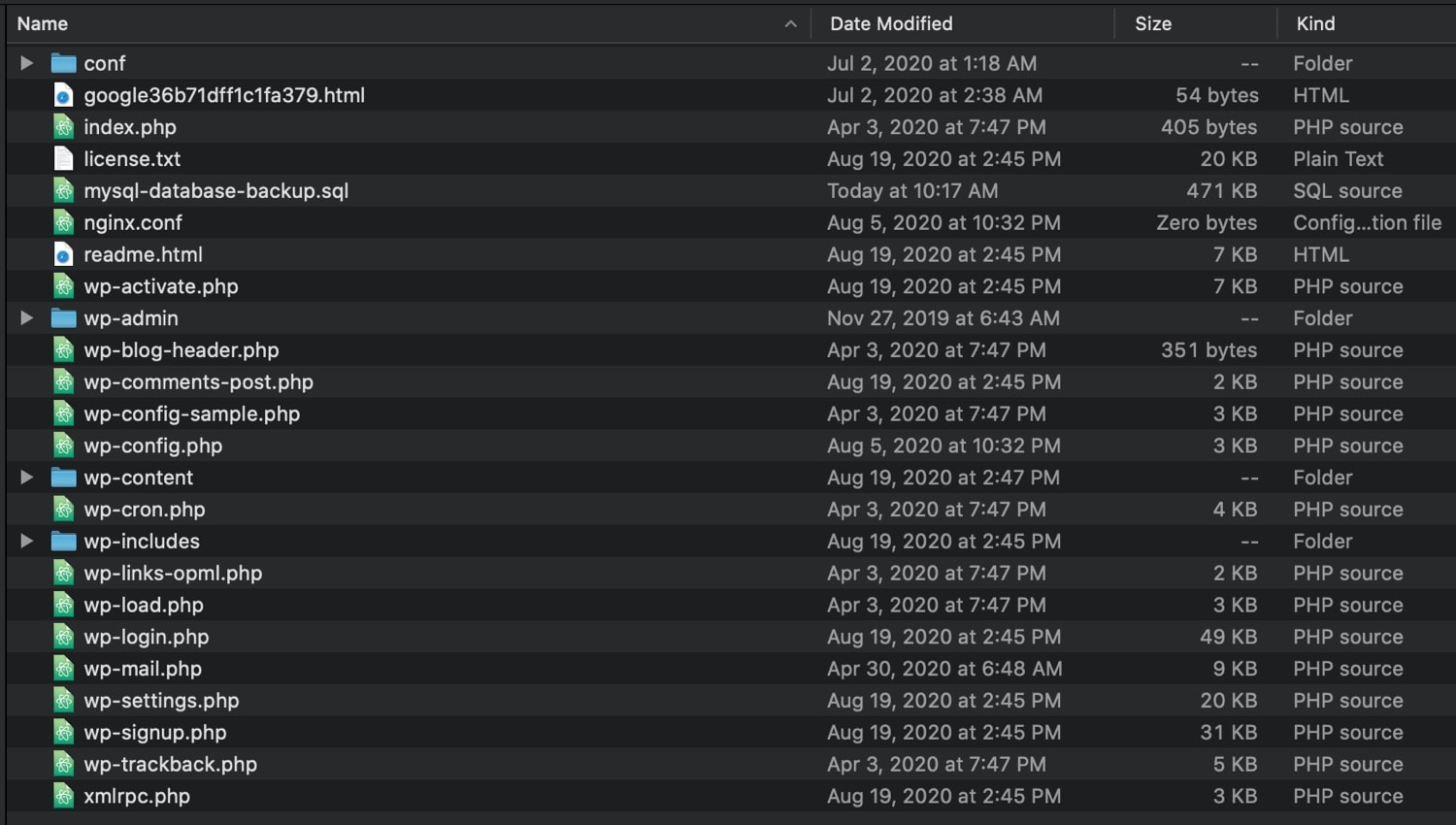
Next, connect to your Kinsta server with your favorite SFTP client and navigate to the ~/public folder. If there are existing files in this folder, go ahead and delete them. Once the folder is empty, transfer your site files (excluding the mysql-database-backup.sql file) from the downloaded backup to the ~/public folder.
After the files have been transferred, open the wp-config.php file and verify the DB_NAME, DB_USER, and DB_PASSWORD match the credentials under Database Access on your site’s Info tab in MyKinsta.
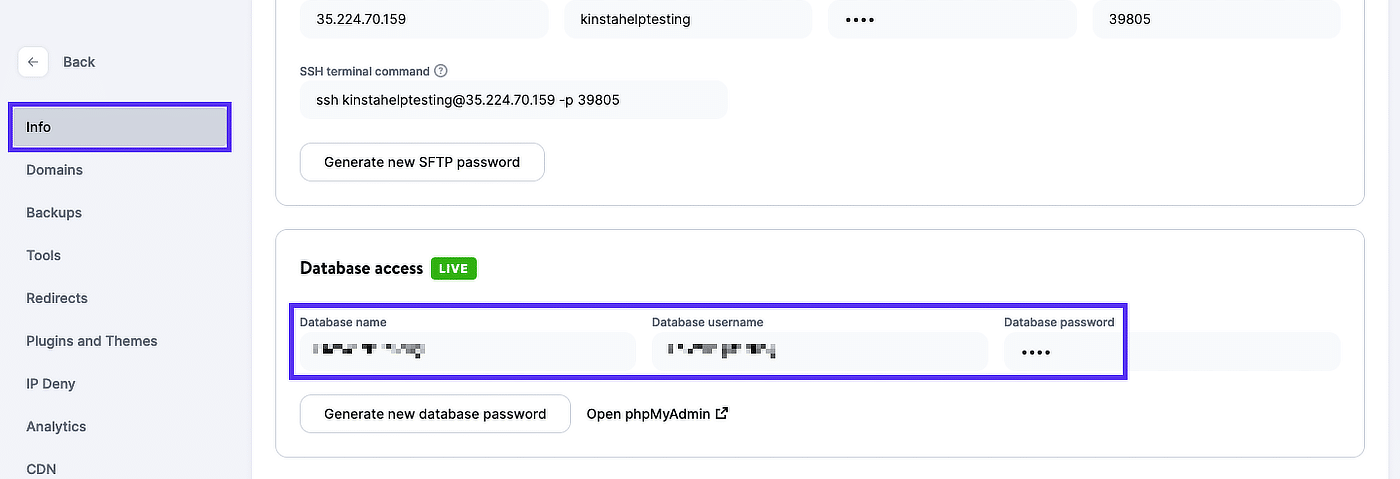
Next, you’ll need to delete the existing database tables and upload the database file from your downloaded backup. To start, log in to your site’s phpMyAdmin, and scroll down to the bottom of the page. Click on the checkbox next to Check All and use the dropdown to choose the Drop option. You will then be prompted to confirm the database query. Select Yes to complete the deletion process.
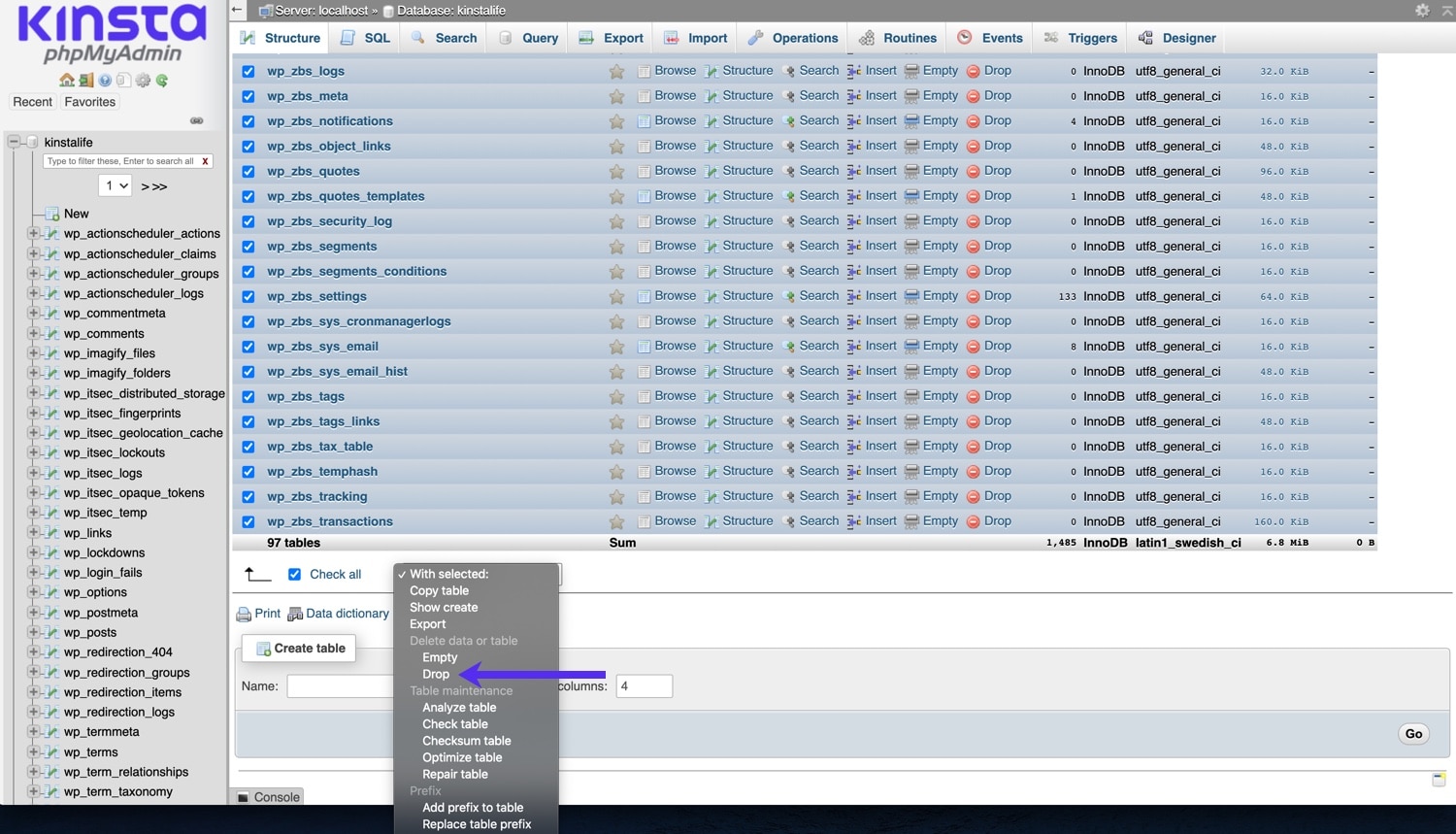
Next, click on the Import tab in phpMyAdmin. Under Files to Import, click Choose File and select the mysql-database-backup.sql file from your downloaded backup. You can leave the other options in their default setting. To finish the database import, scroll down and click the Go button.
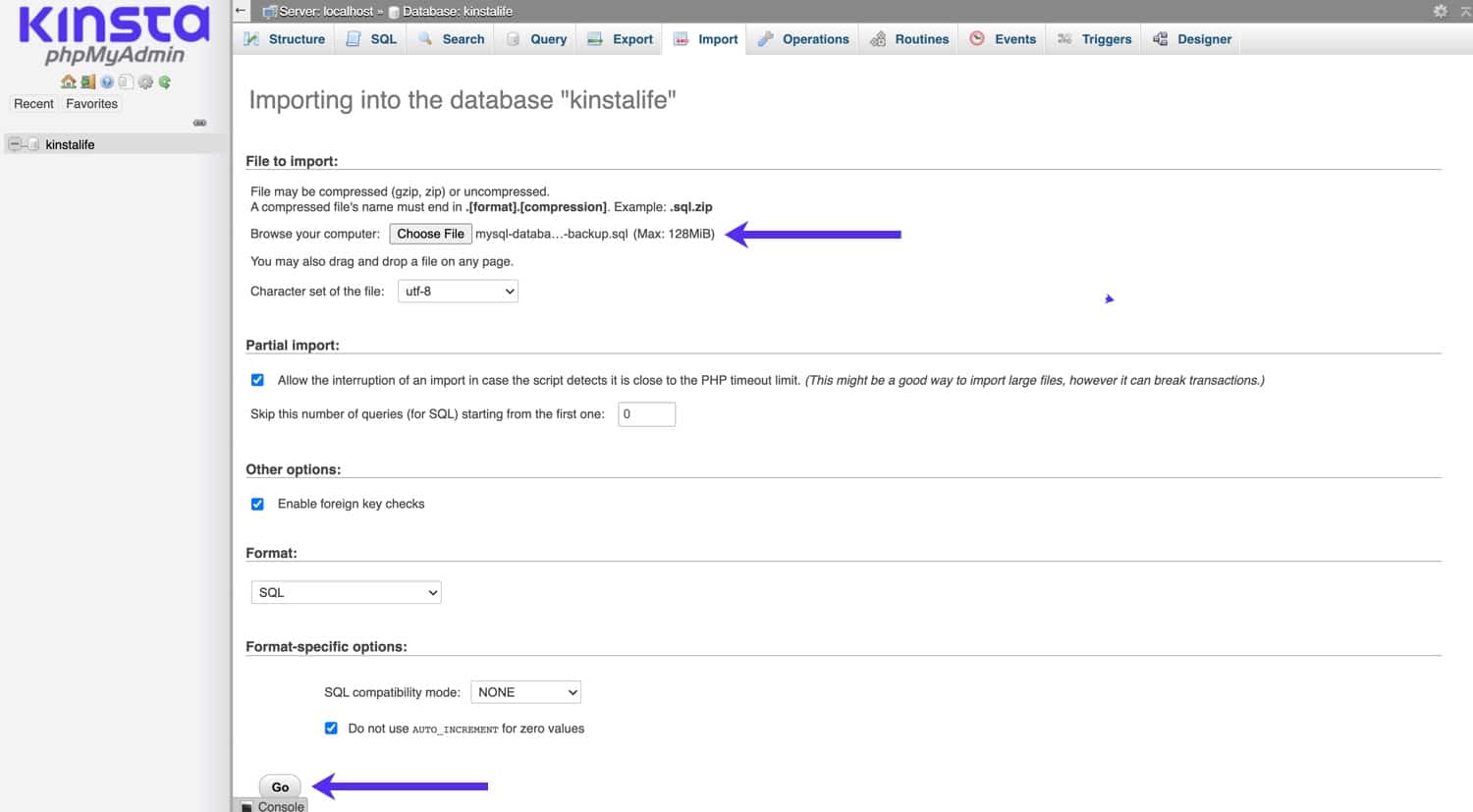
After the database import, you’ll be able to see the database tables from your downloaded backup. If you run into a timeout issue during the database import, your database file may be too large for phpMyAdmin’s web uploader. If that is the case, you can try uploading the database file to your site’s ~/private folder and importing it via the command line. If you are uncertain about how to do that, please upload your SQL file to your ~/private folder and open a new chat with our Support team for further assistance.
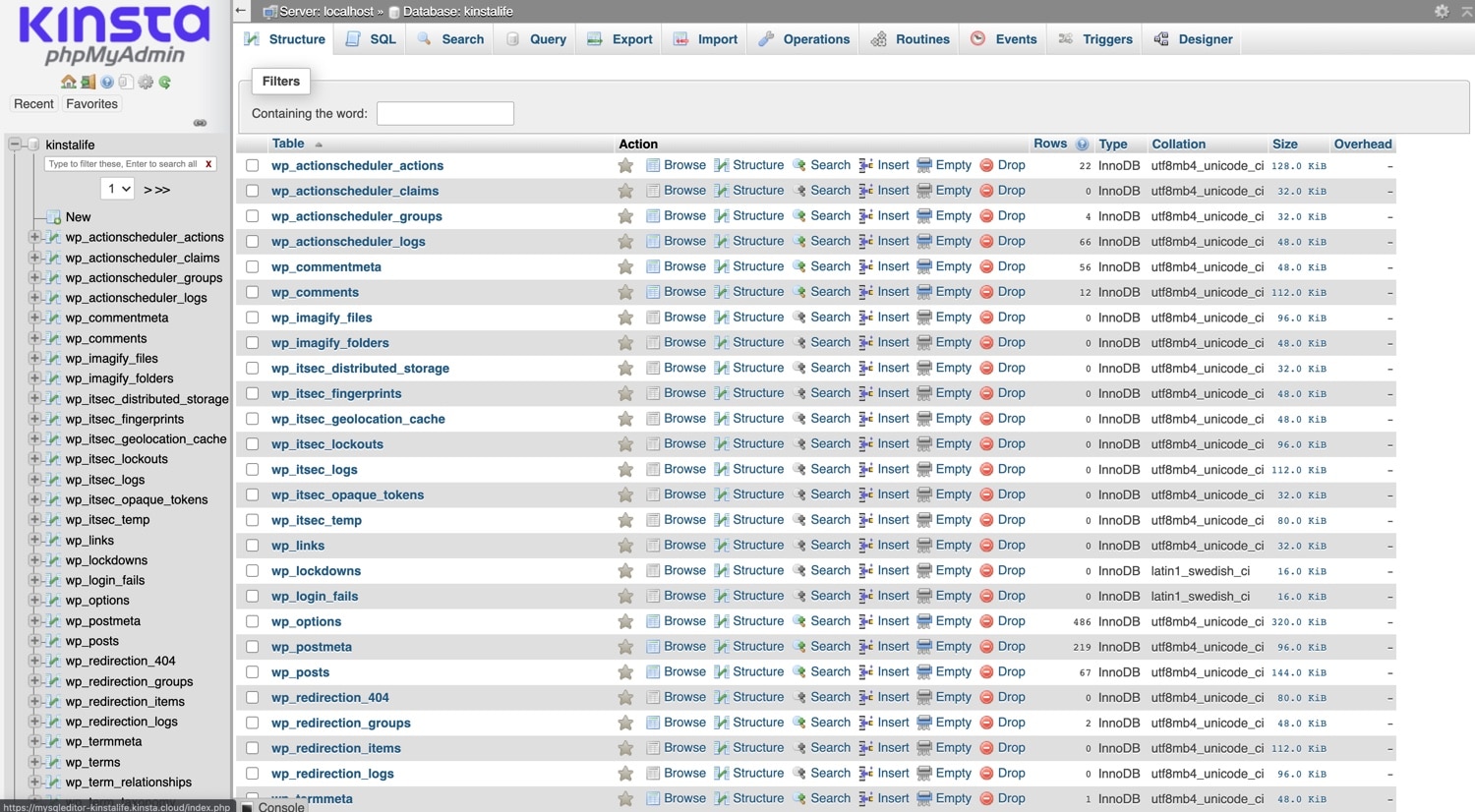
Important Notes Regarding Backups
Here are a few additional things to be aware of regarding backups at Kinsta.
Backup Retention
Depending upon the plan you’re on, the retention period of backups may vary, with the exception of plugin and theme update backups which are only stored for 2 hours.
- Starter through Business 2 plans include 14 days of backups.
- Business 3 and Business 4 plans include 20 days of backups.
- Enterprise 1 and higher plans include 30 days of backups.
Disk Space Excluded From Plan Total
Backups are excluded from our reporting when calculating your total disk space usage to give you as much space as possible. Your usage consists of only your live site’s files and database.